The town of Hearst is located on the Mattawishkwia River in Northern Ontario, approximately 92 km west of Kapuskasing, 935 km north of Toronto and 520 km east of Thunder Bay along Highway 11.
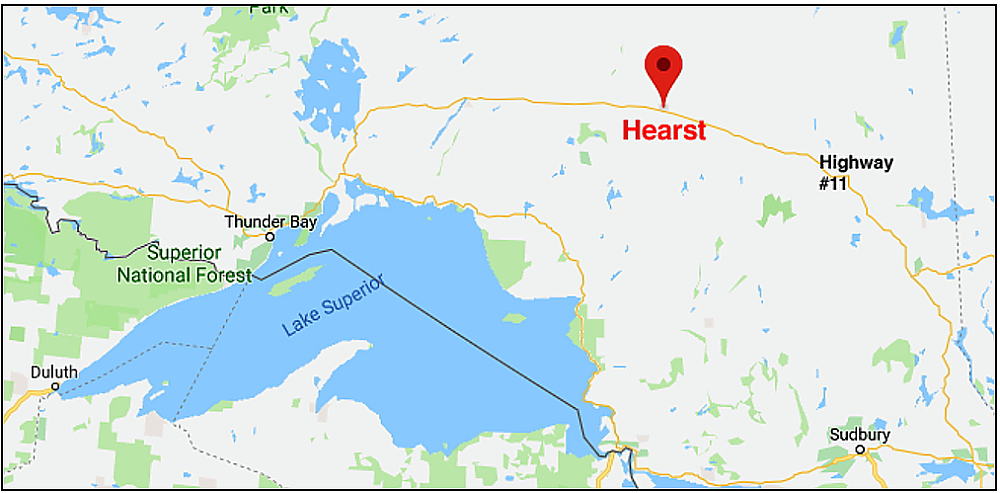
As in most Northern Ontario communities, the arrival of the railway marked the beginning of European descent migration to the area. The National Transcontinental Railway (now Canadian National) arrived in 1912 and the Algoma Central and Hudson Bay Railway in 1914. From then until the 1930s, Hearst was an important railway hub.
At the beginning of the twentieth century, the Ontario government promoted colonization by boasting the merits of Northern Ontario agriculture and forestry. The publicity attracted many migrants from Eastern Europe and Scandinavia, as well as others of both British and French Canadian origin. A small settlement called Bradlo, about 10 km from Hearst, became the first Slovak community in Canada. Like others, many of its residents came to farm, but with limited arable soil, they were often forced to turn to the more lucrative forest products industry.
The area logging operations and saw mills, first established around 1912, provided employment on a year-round basis. The economy grew and from the post war years until the 1980s, Hearst developed rapidly. Between 1941 and 1981, the population increased from about a thousand persons to more than fifty-five hundred – a little more than where it was during the 2016 census.
Today Hearst is renowned for hunting (it proclaimed itself the moose capital of Canada years ago), fishing and numerous snowmobile trails. The wood product industry is still present with Tembec and Columbia Forest Products operations in the community.
With a large percentage of Francophone residents, it is also home to a French-language satellite campus of Laurentian University, the Université de Hearst.
With regards to policing, the Hearst Town Council Minutes from 1922-1925 reported that on September 5th 1922: ". . . the acting clerk advertise for the position of Town Policeman". On September 28th we learn: "That Robert Sharpe be appointed as Chief Constable . . . with a salary of $100 per month and two uniforms per year". (Note: the name is spelled both ways at this time). There must have been some negotiation between Sharp and the Council as a special meeting reported that: "An offer of $112.50 be made to Robert Sharpe and he supply his own uniforms for the position of Town Constable". This was accepted and Chief Sharp assumed the position.
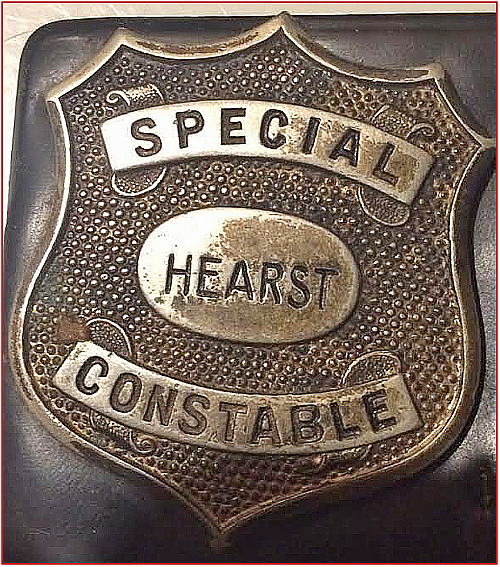
Two weeks later, the town decided to also make him a Special Constable for the enforcement of the Ontario Temperance Act. Sharp's salary increased to $125 dollars/month. By January he had received a monthly raise of $25 for taking on other unpaid responsibilities.
Bob Sharp's actual Special Constable badge is shown at the left. (Courtesy of his great grandson John Sharp via Ernie Bies).
The January minutes also mention a Constable Bush who appears to have been a second officer the town had hired to assist the Chief – likely as the night patrolman.
The next two years saw a tempestuous relationship between Chief Sharp and the town. In a rather succinct summary by historian Ernie Bies, we learn that from 1922 to 1924:
"He was the Golden Boy doing all kinds of extra jobs, got a raise, got fired, got reinstated at a lower salary, got caught with his hand in the till; got suspended; sued the town; got reinstated; got fired a final time; law suit settled for $100; kept his raincoat and hand cuffs so the town had to buy new ones; all in the space of just over two years."
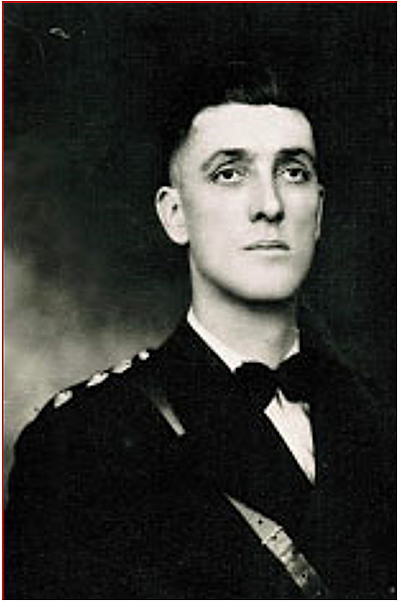
The relationship finally ended on December 23, 1924, and about a month later, on February 1, 1926, W.J. Robinson became Chief Constable. It was during Chief Robinson's tenure that Eugène Desgroseilliers was hired as a town constable.
As with the case of many small Ontario communities, early municipal policing photos did not always survive the passage of time, unless they were part of a family's collection. One such family was the Desgroseilliers.
Great granddaughter Yvonne Demoskoff's blog, reports Eugène Desgroseilliers (at the left) was born in 1900 and became a farmer in Moonbeam, Ontario. (yvonnesgenealogyblog)
Upon moving to Hearst, he became its fourth town constable serving from December, 1927 until February, 1928, when he was appointed Police Chief.
While we are not sure what other credentials he may have brought to the job, it can be reasonably assumed that his imposing height of 6'7" may have had something to do with his selection. The picture below, taken in the 1930s, shows him towering over the average townsmen.
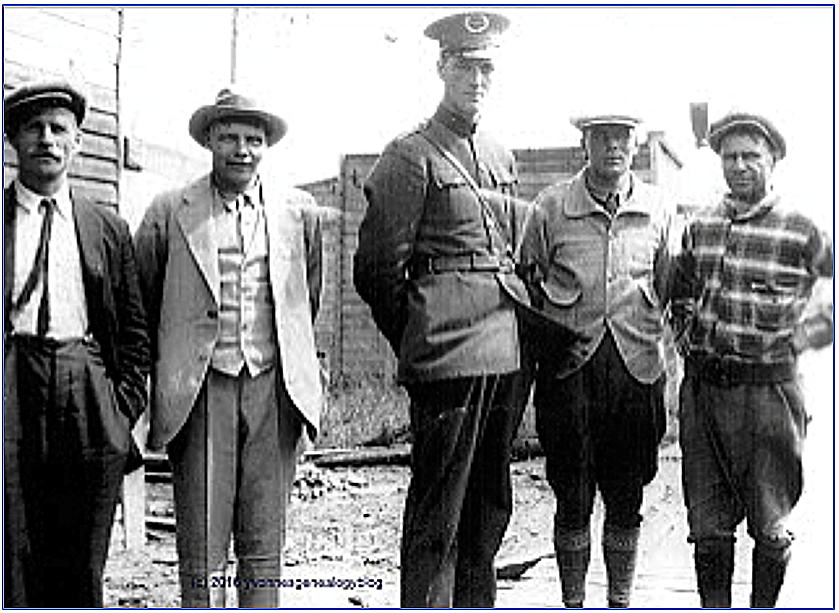
After leaving Hearst in December, 1934, he became Chief of the Rouyn police for two years, before he was appointed by the Quebec government as the Liquor Commission Inspector for Northwestern Quebec.
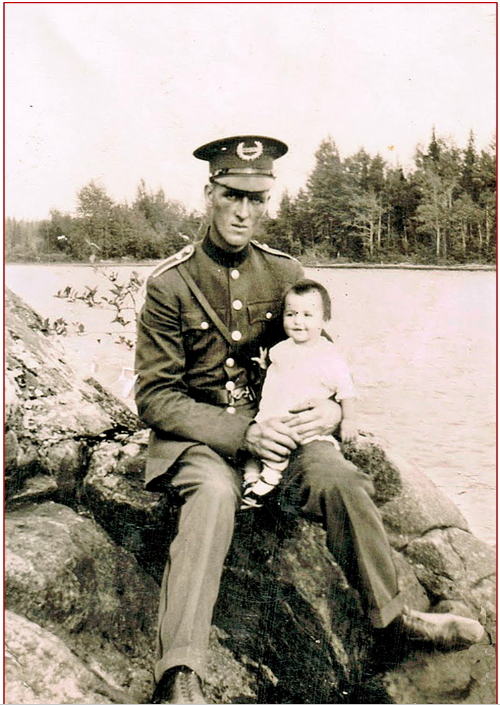
The photo at the left shows him with a generic hat badge commonly supplied to small forces in the early 1930s. It was a relatively inexpensive way to denote rank rather than having a bespoke version designed and cast for the town.
The version at left would be very similar to the one shown below.

Desgroseilliers returned to serve as Hearst's chief from Aug. 19, 1952 to Feb. 7, 1953. He died in the summer of 1960.
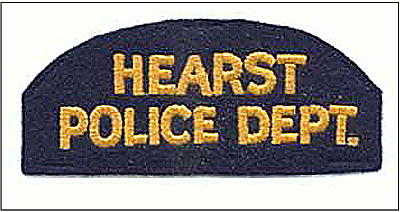
Patches like the one shown on the right began to appear in Ontario in the mid to late 1950s.
Frank Reid was Hearst chief from January 21, 1935 until June, 1941, followed by J.E. Phillion a month later. He stayed until March 24 when he was replaced by the highly popular, Oscar Morel. An article that appeared in the Porcupine Advance newspaper on January 1, 1944, began by pointing out that: "There have been towns in the North where a policeman's lot was not a happy one. In Timmins, police get more brickbats than bouquets. They don't expect anything else".
In contrast, the author went on to say that the people of Hearst had filled the local theatre one evening to honour their retiring Chief of Police, Oscar Morel. The mayor had spoken in praise of the Chief with Councilors and other prominent citizens adding their "good words". According to the mayor, "The police chief had proved a terror to evil doers and a praise to them that do well." [sic].
The crowd cheered and then Morel was presented with two travelling bags and a sum of over $100. The article went on to explain that Chief Morel had been the town's chief constable for over two years and in the North, that proved that he was an unusually good man, or the people were unusually good, or a little bit of both.
The photo below shows an OPP constable on the left and Morel's replacement, Chief Raymond Ringuette. It was taken at the VE Day (Victory in Europe) celebrations in 1945. Ringuette's term began on July 4, 1944 and lasted until April of 1945.
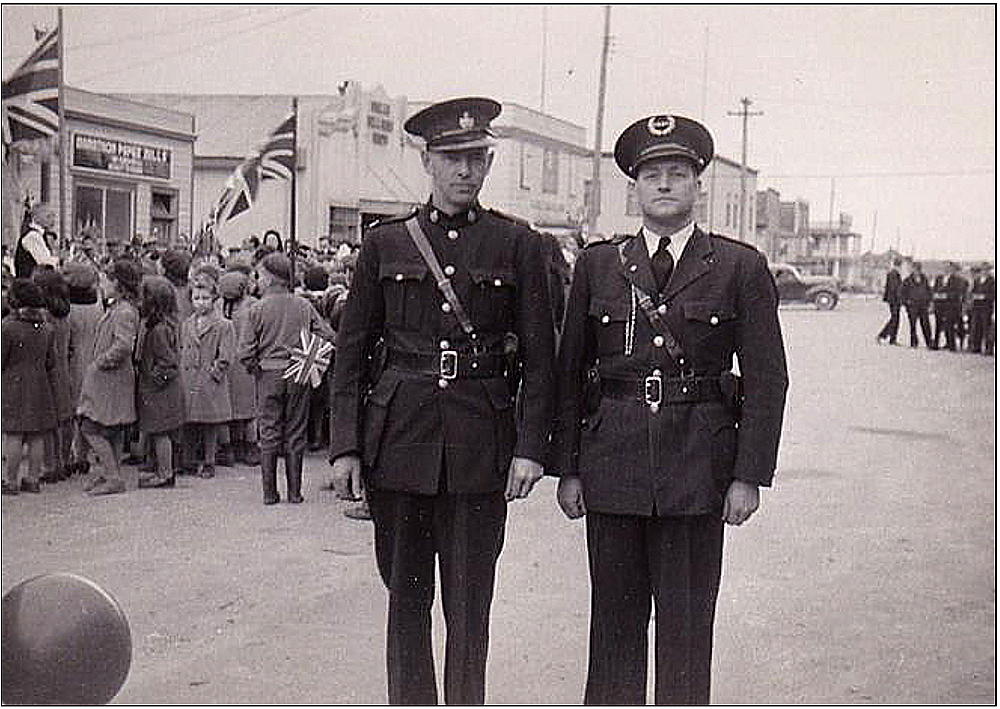
Ferdinand Clement was Chief from April to June of 1945 – typical of the rather rapid officer turn-over rate in Hearst prior to 1955. See Appendix B.
The OPP had already arrived in 1939 to patrol provincial highways and to deal with provincial policing issue. They would have also assisted the local constables when called upon. The OPP officer shown below, left, is Larry Leblanc shown c. 1940s.
The photo, below, right, likely taken in the early 1950s, is the same officer except he is wearing a Hearst Police Chief uniform. We know that Leblanc transferred to the municipal police force as a constable in November of 1947. In 1949, he became the town's Chief and served until October 1951. Leblanc was quoted in Daily Press newspaper as saying: "Hearst is a likeable town with the best of people".
In fact, he liked it so much that he decided to settle permanently in the community and become an entrepreneur as owner of the Western Tire Auto Store on Front Street.
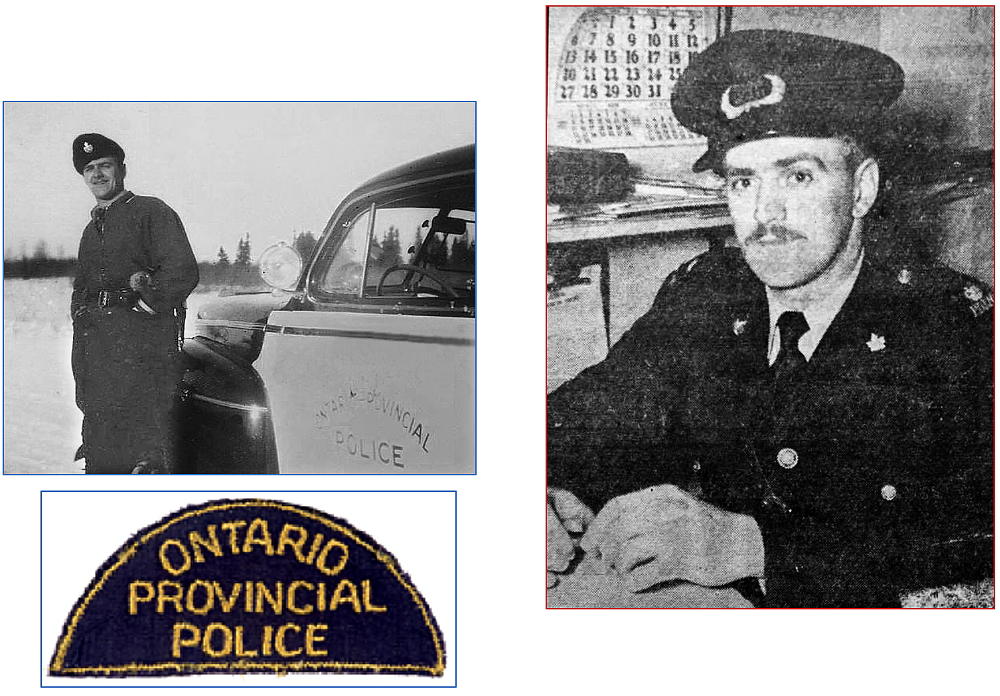
This photo was published in an article dated the 28th of July, 1982, in the Northern Times Special, Hearst's 60th Anniversary newspaper. The picture was actually taken in the mid-1960s, and shows Hearst Police Chief Pat Veilleux with a newly acquired speed radar system mounted on his 1966 Chevrolet police cruiser. (Photo is from the collection of Alan Jansson).

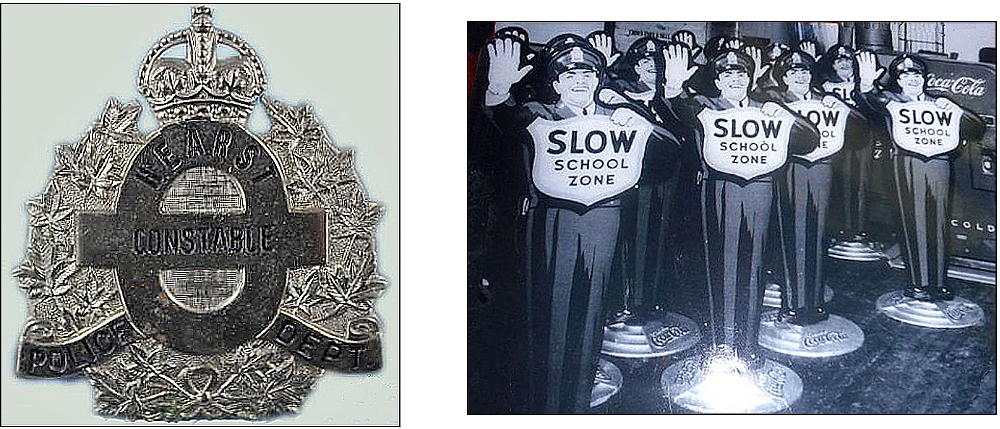
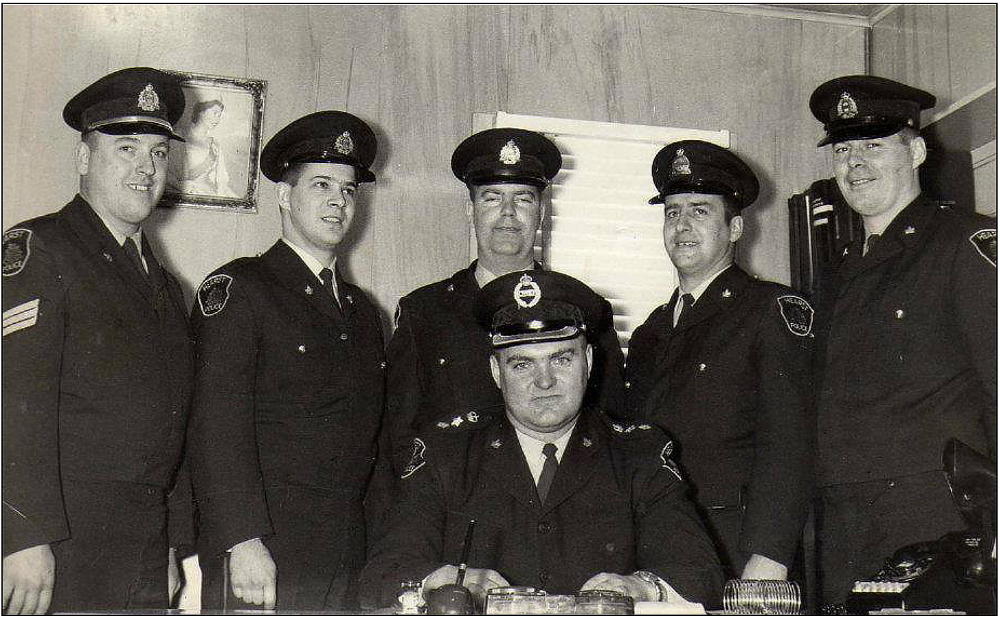
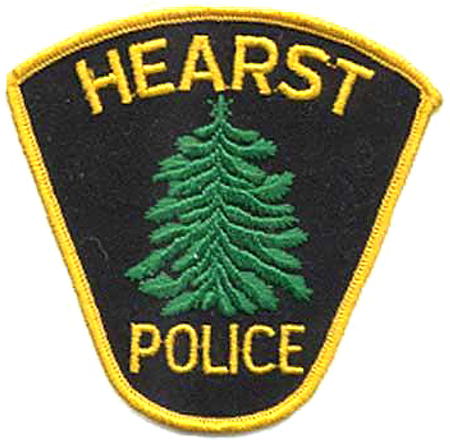
This was the Hearst Police Force in 1967. The officers in the back row are, from left to right, Sergeant Ron Gonzalez, Constables André Brochu, Jim Hatch, Jean Guy Carrier, and Gerald Gignac. Seated is Police Chief Pat Veilleux. (From the collection of Shirley Carrier).
The force is shown wearing the patch at the left.
The town's small municipal police department was not the only source of law enforcement in the community.
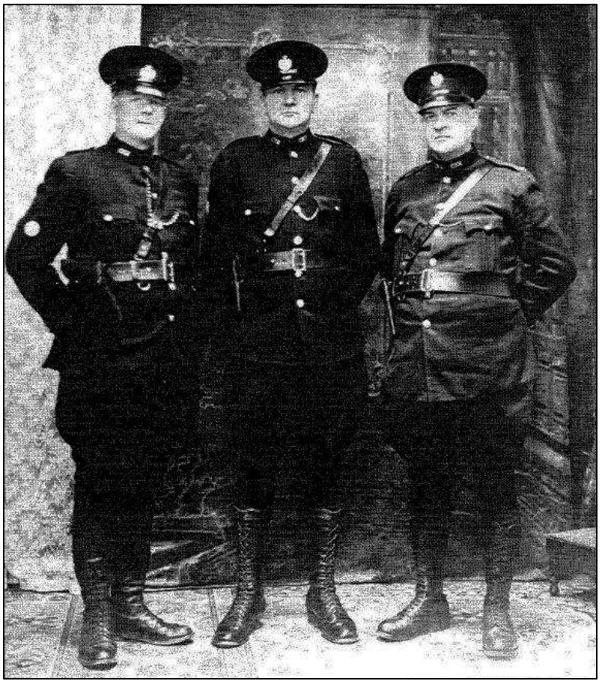
With Hearst being, at one time, the terminus of the Algoma Central Railroad and the connection point to the Canadian National Railway, the CNR stationed one of their police officers in the town to ensure the security of the property and their fare system.
Occasionally, the town police and CN officer would back each other up when required.
John Teggin, shown on the left in this photo was described as a tough CN cop but also a long time, respected member of the Hearst community.
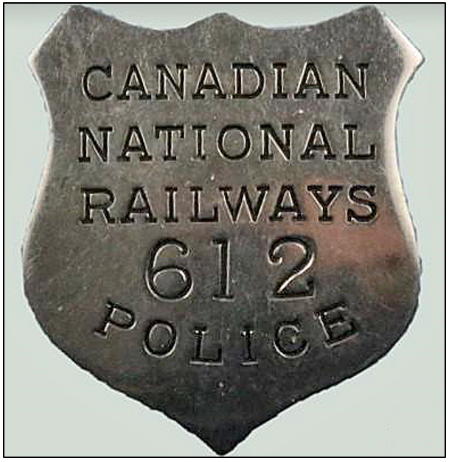
On occasion, he was known to work with Eugène Desgroseilliers. The giant of a police chief and the tough John Teggin must have presented a formidable sight to those trying to ride the rails without a ticket.
This photo, taken c.1926, shows officers representing CN's Northern Quebec and Northern Ontario detachments. From left to right: Constable John Teggin (Hearst), Constable Ed Guertin (Cochrane) and Constable P. Poirier (Taschereau Que.). (From the collection of Alan Jansson).
Hearst maintained its own municipal police department until July 15, 1968, when it was disbanded. The OPP, which had maintained a presence in the area for twenty-nine years, took over the responsibility for the policing of the town.
Please note the Appendices on the following pages.
This document is published solely for the purpose of research, private study, or education. It contains material permitted under the Copyright Act., R.S.C, c. c-42, s. 29. All badge and patch images shown in this article are courtesy of the Canadian Police Insignia Collectors Association. Edited by Robert Martin.
Appendix A – Genuine Hearst patches vs questionable issues.

The patch shown at the left is an example of an original issue from the town of Hearst. There are two variations – one has a cheese cloth backing that is shown below left and the other has a cloth backing that is shown below right. On the genuine patches, the "L" in "POLICE" will have a consistent width for the vertical and horizontal lines.
Genuine patches have significant differences in the tree design and the width of the letters that make up the word "HEARST". See the next page for more details.
Thanks to Bob Pyefinch for these images.
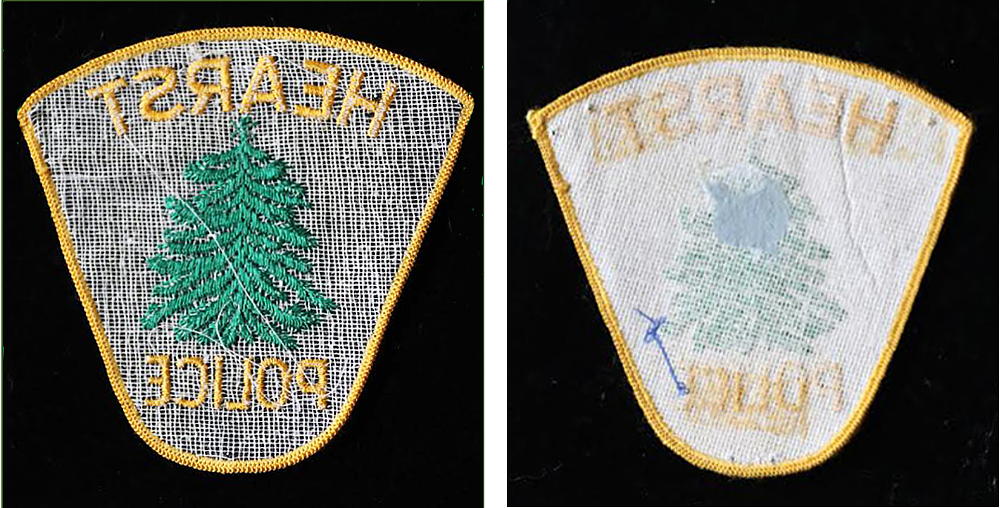
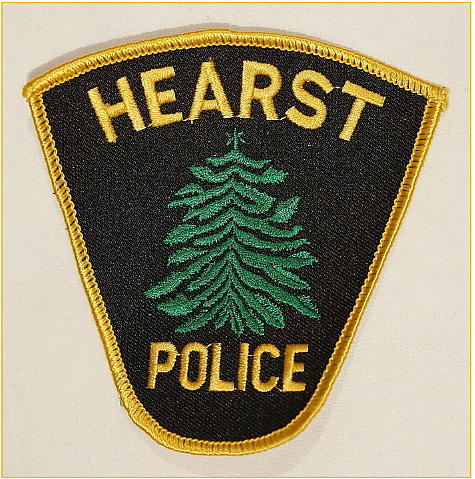
The patch shown at the left is considered to be a reproduction.
It is unlikely to have ever been used by a Hearst municipal police officer.
The unhappy buyer appeared to agree.
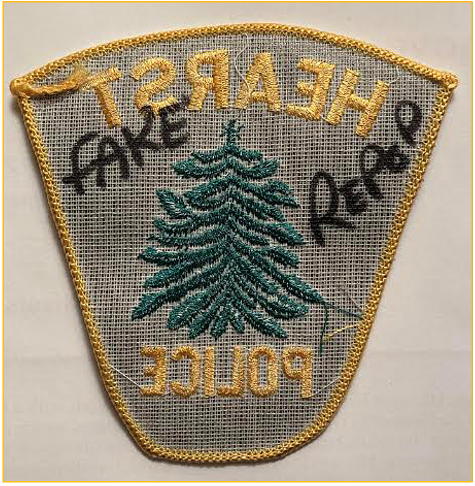
The backing on the questionable patch, shown at the right, has a plastic type material applied over the weaving. It can be detected by holding the patch on an angle to a strong light. It will appear to have a sheen to the backing surface.
If one compares the photo above with the photo of the genuine patch (the top photo in this Appendix), one will note that the tree branches on the issued patch have small spaces between them especially at the point where they are "attached" to the tree.
Again, notice the thicker letters on the questionable patch.
Appendix B – Hearst Chiefs of Police and known constables.
(List supplied by Ernie Bies. Courtesy town of Hearst)
Robert Sharp, Chief, September 12, 1922 to December 23, 1924.
Alf Trowsse, Constable, March 2, 1924 to October 22, 1925.
W.J. Robinson, Chief, February 1, 1926 to February 8, 1928.
Eugène Desgroseillers, Constable, December 19, 1927 to February 20, 1928.
Eugène Desgroseillers, Chief, February 20, 1928 to December 27, 1934.
W. Lacalle, Acting Constable, November 21, 1932 to August 11, 1933.
Frank Reid, Chief, January 21, 1935 to June 10, 1941.
G.F. Phillion, Constable, March 18, 1941 to May 23, 1941.
J.E. Phillion, Chief, July 31, 1941 to March 24, 1942.
Oscar Morel, Chief, April 27, 1942 to May 2, 1944.
Raymond Ringuette, Chief, July 4, 1944 to April 3, 1945.
Ferdinand Clement, Chief, April 3, 1945 to June 30, 1945.
James Marconi, Special Constable, May 29, 1945 to February 19, 1946.
Azarie Farley, Chief, October 25, 1945 to April 6, 1946.
J.L. Leblanc, Constable, November 25, 1947 to November 16 1949.
J.L. Leblanc, Chief, November 21, 1949 to October 16, 1951.
Raymond Marchand, Constable, November 21, 1949 to June 14, 1950.
Peter Jeffrey, Constable, July 26, 1950 to June 14, 1950.
E.L. Hill, Constable, September 6, 1956 to October 9, 1951.
E.L. Hill, Chief, December 1, 1951 to August 5, 1952.
Gordon Caldwell, Constable, November 6, 1951 to January 11, 1952.
Raymond Ringuette, Constable, February 22, 1952 to February 7, 1953.
Eugène Desgroseillers, Chief, August 19, 1952 to February 7, 1953.
Larry Leblanc, Special Constable, January 14, 1953.
J. Laframboise, Constable, January 31, 1953 to March 31, 1953.
Clifford Found, Chief, February 7, 1953 to March 31, 1953.
Clifford Found, Constable, March 31, 1953.
A.H. Souliere, Chief, April 7, 1953 to December 2, 1953.
Frank Hopewood, Constable, May 5, 1953 to June 30th 1953.
Raymond Charron, Constable, September 8, 1953 to March 31, 1954.
Homer Gauthier, Acting Chief, December 2, 1953 to April 7, 1954.
Douglas Barnes, Chief, April 7, 1954.
D. Wheeldon, Chief, 1955.
On November 22nd, 1955, a Police Commission was established. From here on, the hiring of police officers was made through the Commission.
Julien Plouffe, Chief, April 1960.
Patrice Veilleux, Chief, February 1964 to July 15, 1968.
Ron Gonzalez, Sergeant, To July 15, 1968.
André Brochu, Constable, To July 15, 1968.
Jim Hatch, Constable, To July 15, 1968.
Jean Guy Carrier, Constable, To July 15, 1968.
Gerald Gignac, Constable, To July 15, 1968.
Can you provide corrections or comments?
Please report technical issues to: